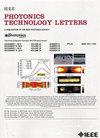使用宽带弯曲定向耦合器增强硅MZI滤波器的工作范围
IF 2.3
3区 工程技术
Q2 ENGINEERING, ELECTRICAL & ELECTRONIC
引用次数: 0
摘要
马赫-泽恩德干涉仪(MZI)是用于各种波分复用(WDM)系统的重要组件。在传统的基于波导的马赫-泽恩德干涉仪中,波长敏感的直定向耦合器(DC)通常用作分束器和合路器,这通常会限制工作带宽并造成额外的插入损耗。为了克服这些挑战,我们提出了一种基于弯曲DC的MZI,其工作波长范围增加了2.7倍,带宽从基于直DC的MZI的36.7 nm扩展到至少100 nm,同时保持了较大的消光比(ER)。所提出的 MZI 在 300 mm 晶圆上具有很强的鲁棒性,在所有 63 个测量的裸片中,100 nm 波长范围内的最小消光比为 ${mathrm {14.3 }}sim {\mathrm {18.4~dB}}$ ,明显优于基于直 DC 的 MZI,后者的最小消光比为 ${mathrm {4.2~ }}sim {\mathrm {6.1~dB}}$ 。最后,理论证明所提出的 MZI 对于更复杂的波分复用系统具有很高的效率。基于 MZI 的 16 信道波分复用系统的传输矩阵法计算表明,与基于直流的系统相比,最差信道隔离度从 5.42 dB 提高到 17.18 dB,平均插入损耗从 1.02 dB 降低到 0.30 dB。这凸显了拟议的 MZI 在实现可扩展和高性能波分复用系统方面的潜力。本文章由计算机程序翻译,如有差异,请以英文原文为准。
Enhanced Operation Range of Silicon MZI Filters Using a Broadband Bent Directional Coupler
Mach-Zehnder interferometers (MZIs) are essential components that are used in a variety of wavelength division multiplexing (WDM) systems. Wavelength-sensitive straight directional couplers (DCs) are usually used as the beam splitter and combiner in traditional waveguide-based MZIs, which often limit the operational bandwidth and cause additional insertion loss. To overcome these challenges, we present an MZI based on bent DCs achieving $2.7\times $ increase in operational wavelength range, expanding the bandwidth from 36.7 nm in straight DC-based MZIs to at least 100 nm, while maintaining a large extinction ratio (ER) $\mathrm {\geq 18.4~dB}$ . The proposed MZI is robust across a 300 mm wafer, achieving minimum ER over 100 nm wavelength range of ${\mathrm {14.3 }}\sim {\mathrm {18.4~dB}}$ in all the 63 measured dies, significantly outperforming MZIs based on straight DCs, which exhibit minimum ER of ${\mathrm {4.2~ }}\sim {\mathrm {6.1~dB}}$ . Finally, the proposed MZI is theoretically proven to be highly efficient for more complex WDM systems. Transfer matrix method calculations for 16 −channel MZI-based WDM system demonstrate an improvement of the worst-channel isolation from 5.42 dB to 17.18 dB and the average insertion loss from 1.02 dB to 0.30 dB, as compared to the straight DC based counterpart. This underscores the potential of the proposed MZI to enable scalable and high-performance WDM systems.
求助全文
通过发布文献求助,成功后即可免费获取论文全文。
去求助
来源期刊

IEEE Photonics Technology Letters
工程技术-工程:电子与电气
CiteScore
5.00
自引率
3.80%
发文量
404
审稿时长
2.0 months
期刊介绍:
IEEE Photonics Technology Letters addresses all aspects of the IEEE Photonics Society Constitutional Field of Interest with emphasis on photonic/lightwave components and applications, laser physics and systems and laser/electro-optics technology. Examples of subject areas for the above areas of concentration are integrated optic and optoelectronic devices, high-power laser arrays (e.g. diode, CO2), free electron lasers, solid, state lasers, laser materials'' interactions and femtosecond laser techniques. The letters journal publishes engineering, applied physics and physics oriented papers. Emphasis is on rapid publication of timely manuscripts. A goal is to provide a focal point of quality engineering-oriented papers in the electro-optics field not found in other rapid-publication journals.
 求助内容:
求助内容: 应助结果提醒方式:
应助结果提醒方式:


